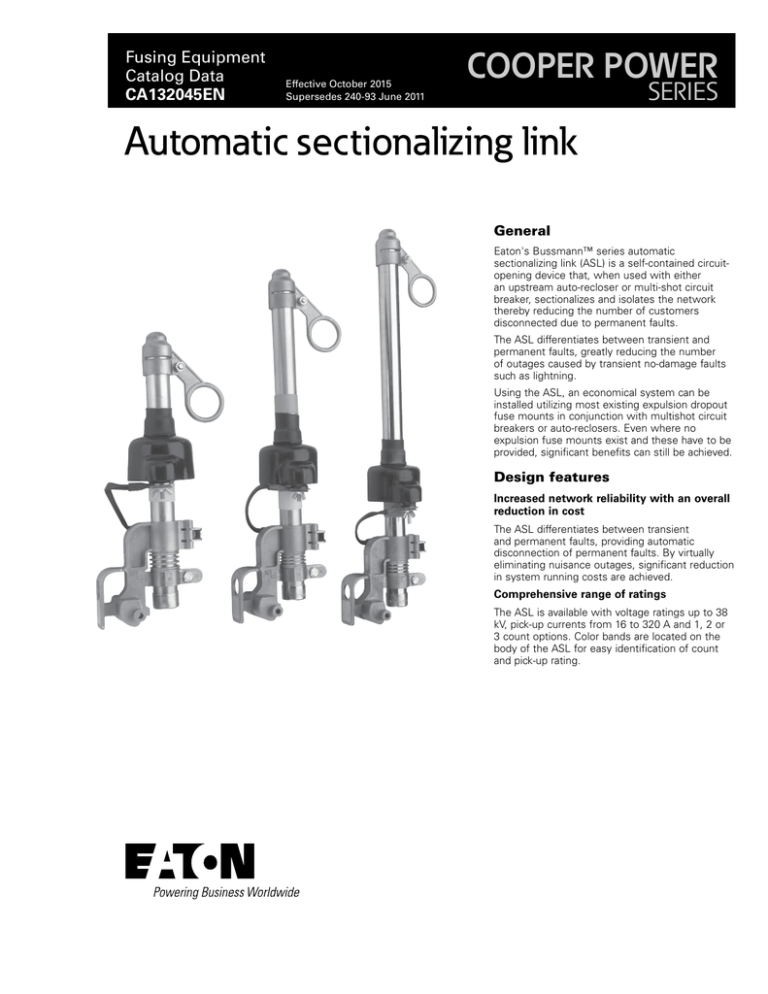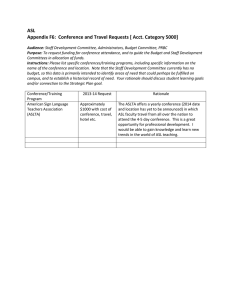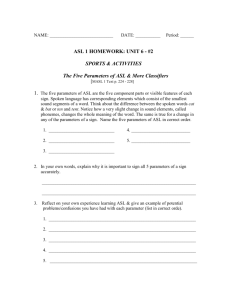
Fusing Equipment
Catalog Data
CA132045EN
Effective October 2015
Supersedes 240-93 June 2011
COOPER POWER
SERIES
Automatic sectionalizing link
General
Eaton's Bussmann™ series automatic
sectionalizing link (ASL) is a self-contained circuitopening device that, when used with either
an upstream auto-recloser or multi-shot circuit
breaker, sectionalizes and isolates the network
thereby reducing the number of customers
disconnected due to permanent faults.
The ASL differentiates between transient and
permanent faults, greatly reducing the number
of outages caused by transient no-damage faults
such as lightning.
Using the ASL, an economical system can be
installed utilizing most existing expulsion dropout
fuse mounts in conjunction with multishot circuit
breakers or auto-reclosers. Even where no
expulsion fuse mounts exist and these have to be
provided, significant benefits can still be achieved.
Design features
Increased network reliability with an overall
reduction in cost
The ASL differentiates between transient
and permanent faults, providing automatic
disconnection of permanent faults. By virtually
eliminating nuisance outages, significant reduction
in system running costs are achieved.
Comprehensive range of ratings
The ASL is available with voltage ratings up to 38
kV, pick-up currents from 16 to 320 A and 1, 2 or
3 count options. Color bands are located on the
body of the ASL for easy identification of count
and pick-up rating.
Catalog Data CA132045EN
Automatic sectionalizing link
Effective October 2015
UPPER CONTACT
LATCHING RING
COLOR BAND
INDICATES NUMBER OF
COUNTS
1 COUNT BROWN
2 COUNT NO BAND
3 COUNT GREEN
ACTUATOR
COLOR BAND
INDICATES PICK-UP
CURRENT
16AYELLOW
24 A RED
40 A BLUE
56 A GREEN
80 A BLACK
112 A WHITE
160 A BROWN
224 A ORANGE
320 A NO BAND
LOWER CONTACT
DIMENSIONS
Voltage
Length
Rating
In (mm)
15 kV
11.50 (292)
27 kV
14.96 (380)
38 kV
18.43 (468)
Figure 1. ASL Construction Detail.
Fits into existing expulsion fuse mounts
Low threshold for hold off current (250 milliamps)
The ASL C-type version fits all the common NEMA® interchangeable
mounts such as Eaton's Cooper Power™ series Type L cutout. They
swing down upon operation, providing visual identification of a
fault downstream. This allows for fast system restoration. ASLs are
installed and removed using existing pole head equipment. Detailed
installation instructions are available with every ASL and also on
request.
A return to load current following a temporary fault will not result in
a mistaken count by the ASL.
Silent, reliable drop-out action
High output force of the replacement actuator provides rapid, reliable
drop out action, even under icing, to provide visual indication of a
faulty line. Dead time operation ensures no sparks, ionized gas or
contact erosion, minimizing fire risks.
Immunity to magnetizing inrush current
Construction
The ASL houses a fully encapsulated logic circuit within its main
conductive tube powered by encapsulated small current transformers mounted on the outside of the tube. This ensures that the electronic circuitry is free from electrical interference as the tube acts
as an effective Faraday cage. The logic circuit is also environmentally
protected to prevent moisture ingress. Energy derived from the
current transformers under fault conditions allows the ASL to be
self powered to ensure operation even when there is no initial load
current.
Surge and EMI protection
In appearance the upper and lower contacts of the ASL resemble
that of the fuse holder it replaces. Instead of a fuse element melting
to release the holder from the mount, operation is accomplished
by discharging a capacitor into a small actuator (or ‘striker’) which
unlatches the holder tube and causes it to swing down in the
manner of an expulsion fuse holder (See Figure 2).
Electronics are shielded from magnetic field influences by being
enclosed within the conducting tube. The ASL is tested to withstand
lightning impulse currents and to be immune to radio frequency
interference.
The actuator is an extremely reliable device with high mechanical
advantage, providing rapid, reliable drop-out action even under icing
conditions. The actuator is completely safe to handle and there are
no special storage or transporting requirements.
Self powered, no maintenance
The ASL is reset by installing a replacement actuator and re-inserting
the holder into its mount. The resetting operation takes less time
than that needed to change a blown expulsion fuse link.
The logic circuit ignores the first half-cycle current and reacts only if
both the negative and positive half cycles exceed the pick-up current.
As magnetizing inrush currents are largely unidirectional they are
ignored by the logic circuit.
The logic circuit and actuator are powered by two current
transformers during the passage of fault current. No additional
power source is required, and no maintenance is needed.
2
www.eaton.com/cooperpowerseries
Catalog Data CA132045EN
Automatic sectionalizing link
Effective October 2015
LATCHED POSITION
DE-LATCHED POSITION
Figure 2. ASL in NEMA style fuse mount.
FAULT CURRENT
LEVEL OF CURRENT
IN THE MAIN LINE
MAGNETIC
INRUSH
CURRENT
NOMINAL LOAD
CURRENT
LINE
RESTORED
AUTO-RECLOSER
CONTACTS
OPEN
CLOSED
TRIP
RECLOSE
OPEN
TRIP
CLOSED
RECLOSE
SECTIONALIZER OPENS
LATERAL LINE
SECTIONALIZER
OPERATION
LATERAL ISOLATED
FIRST PULSE
NOTED AND STORED
IN SECTIONALIZER’S
MEMORY
SECOND
PULSE
NOTED
DEAD
PERIOD
NOTED
Figure 3. Operational sequence of a sectionalizer isolating a lateral line fault (sequence shows a 2 shot device).
www.eaton.com/cooperpowerseries
3
Catalog Data CA132045EN
Automatic sectionalizing link
Effective October 2015
Operation
Application
Under normal load conditions the electronics remain inert. However,
should the line current increase above a pre-set value (the pick-up
current) the logic circuit activates.
The Auto Sectionalizer Link can be installed in existing cutouts at
the head of the laterals or branches on a distribution system, downstream from an auto-recloser or multi-shot circuit breaker. Figure 5
illustrates a typical protection scheme used on a distribution system,
utilizing ASLs instead of the typically used fuse links.
The upstream auto-recloser then opens, temporarily removing the
fault from the line. The ASL’s logic circuit, powered by an internal
capacitor, stores the incident for around 25 seconds (the ‘reclaim
time’).
The most common type of overhead primary distribution circuit is
the four-wire multi-grounded neutral system. A main line (feeder)
with a recloser near its head originates from a substation with
several laterals tapped off this feeder. Often further branch lines
are tapped off the lateral which in turn supply power to end users.
Transformers are individually fused and fuses at the head of
branches and laterals provide further sectionalizing of the system.
When the upstream device recloses, typically 3 to 10 seconds later,
if the fault current is no longer in evidence, the ASL will ignore the
incident after the reclaim time and eventually reverts to an inert state
again. However, if the fault current (i.e. current above the pick-up
current) is still present, the logic circuit will decide that this represents a permanent fault on the lateral line and for a two-count unit
will prepare to de-latch.
In general, the individual transformer fuse links are sized to operate
on all selected overcurrents without causing the recloser to operate.
Operation of this fuse link affects a small number of customers
making such operations easily justifiable.
The logic circuit is inhibited from operating the latch mechanism
until the upstream recloser has tripped for the second time and the
line current has fallen to a value of less than 250 mA (the ‘hold-off’
current) for a period of at least 0.1 seconds.
The fuse link at the head of the lateral or branch coordinates with
the recloser with some limitations. There is a maximum current
beyond which the fuse link will operate before the recloser has a
chance to clear a temporary fault. Under high transient fault conditions, such as a lightning strike, nuisance fuse link blowing can
result.
The ASL thus operates during the dead time of the upstream protective device and does so quickly, without sparks or ionized gas emission and without contact erosion.
The logic circuit is designed to inhibit response to transformer
magnetizing inrush current surges. Thus ASLs on non-faulted
lateral lines are not spuriously operated by such currents, following
repeated operations of the upstream recloser.
Most distribution circuits have multiple expulsion fuse links in series.
Due to the non-current limiting nature of expulsion fuse links, there
is a maximum current at which coordination can be achieved. Above
this current it is likely that both the upstream and downstream expulsion fuse links will operate at the same time.
In practice, any lateral line fault condition that persists for a time
long enough to operate the upstream recloser will operate the ASL,
isolating the lateral. Any transient or ‘no-damage’ current will be
ignored (See Figure 3).
By replacing a fuse with an ASL at the head of a lateral or branch,
as illustrated in Figure 4, the coordination range is extended to the
maximum short time withstand rating of the ASL. ASLs have no
Pole mounted auto re-closer
TRANSFORMER
PMAR
CUTOUT
3 COUNT ASL
ASL
LATERAL
ASL
ASL
2 COUNT ASL
ASL
MAIN OVERHEAD LINE OR FEEDER
Figure 4. Typical distribution system using ASLs.
4
www.eaton.com/cooperpowerseries
2 COUNT ASL
2 COUNT ASL
Catalog Data CA132045EN
Automatic sectionalizing link
Effective October 2015
time-current characteristics and are easily applied between two
fault-interrupting protective devices. Accordingly, they are easily
added to an existing system or to an existing coordination plan when
additional circuit sectionalizing is needed.
The main advantage of the ASL is that transient fault interruption
can be effectively achieved with the pole-mounted auto-recloser or
multishot circuit breaker down to the minimum operating current of
the ASL, without the necessity for delayed trips. Auto-reclosers can
therefore be set for instantaneous trip, minimizing system damage.
Fault withstand is not an issue as the short time-current withstand
rating of the ASL will be greater than the available fault current
except for a few possible applications next to a substation.
In the case of low ground fault currents, by selecting an ASL with
minimum pick-up current at or below the minimum trip current of
the auto-recloser, where possible, these ground faults will result in
operation of the ASL on the faulty lateral, thus preventing lockout of
the recloser and wide loss of supply to customers. To achieve the
optimum level of coordination and to take account of tolerances, the
lowest rating of ASL should be 80% of the ground fault or sensitive
ground fault settings, dependent on the scheme employed.
Number of counts
The number of counts to operate is factory preset. The ASL should
be chosen with at least one less count than the up-stream recloser.
For example, a 4 shot recloser should be matched with a maximum
of a 3 count ASL downstream. To reduce the number of recloser
operations, a 2 count ASL unit would be the most common. Where
ASLs are used in series, the downstream ASL should be one less
count than the up-stream ASL. 1 count ASLs are also available for
applications such as underground cables where transient faults are
unlikely. The choice of an ASL over a fuse eliminates the coordination
issues discussed previously.
Maximum fault current
Be sure the ASL has a short time-current withstand equal to or
greater than the available fault current (See Table 1 Performance
Characteristics).
Continuous current
The ASL's continuous current rating must be equal to or greater than
the system load current. This is normally not an issue, as all ASLs
are rated at 200 A continuous.
Selection
Reclaim time
When selecting an ASL for a specific installation, a number of factors
should be considered.
The reclaim time is the time that the memory of the ASL retains
prior counts and is nominally 25 seconds. However in practice this
time will vary with the value and duration of fault current pulses. For
high values of fault current, particularly where the upstream recloser
is operating in delayed mode, the ASL reclaim time may extend by
up to 15% while for instantaneous tripping operation at lower values
of current near the pick-up value, reclaim times will be reduced.
For details see Performance Characteristics. For these reasons it is
recommended that the maximum reclose time (dead time between
shots) of the recloser be 15 seconds, as this must be shorter than
the ASL reset time for correct coordination. If the auto-recloser is
operating in the instantaneous region of the trip characteristic near
the pick-up current of the ASL, the auto-recloser dead time should
not exceed 10 seconds.
System voltage
The ASL is insensitive to system voltage, and being in effect a solid
conductor, has no insulation requirements. Hence the sole criterion
concerning voltage is that the ASL fits into a mount of the appropriate voltage rating, meeting the dielectric values required (BIL and
power frequency).
Pick-up current (actuating current)
For optimum coordination the lowest rating of ASL should be 80% of
the minimum ground fault or sensitive ground fault settings allowing
auto-recloser operations.
However, depending on the position of the ASL, it must be chosen
to withstand the possible transformer magnetizing inrush currents.
When a recloser switches in and out attempting to clear a fault
on one branch circuit, all the non-faulted circuits experience surge
currents due to magnetizing inrush determined by the transformer
kVA.
The anti-magnetizing inrush circuit in the ASL ensures against spurious operation, provided both positive and negative going half cycles
are below the pick-up value. If the ratio of transformer capacity/
pick-up settings is made too small, then even the smaller loops
of the highly asymmetrical magnetizing inrush current, may be of
sufficient value to override the inhibiting circuit and allow operation
to occur.
IEEE Std C37.63™ standard for mainline sectionalizers allows a ratio
of 1.6:1 for pick-up current to total available transformer current.
Present experience suggests that this is satisfactory for most
applications of 2 and 3 count ASLs. For 1 count ASLs and
applications where the transformer kVA is dominated by one large
transformer, (i.e. more than 60% of the total), a ratio of 2.5:1 is
recommended.
For example: for 2 and 3 count ASLs a 40 A pick-up setting allows for
maximum installed transformer capacity of up to 25 A. Even though
the maximum loading on the line might be 5 A, a small percentage
of the maximum available, magnetizing inrush dependent on the
installed kVA is the determining factor.
Overvoltage withstand
ASLs have been tested to withstand 65 kA lightning surge current as
defined in IEEE Std C37.63™ and IEEE Std C62.11™ standards and
IEC 60099 for surge arresters.
Load breaking
The ASL is designed for deadbreak operation only. If the unit is
manually opened under live line conditions, an arc will be drawn
across the contacts exactly as in the case of an expulsion fuse. If
the current is low enough and if conditions are favorable, the arc
may extinguish as the unit drops down to the isolating position.
Therefore the same operating procedures will apply for the ASL as
for expulsion fuses with regard to breaking load.
NEMA® Interchangeable mounts are fitted with hooks, for use with
a load-break tool. To open the ASL under load, use an appropriate
load break tool designed for use with interchangeable cutouts and
follow instructions provided with the tool.
Dead time
The time for an ASL to drop down to a safe isolating distance (from
the instant when the line goes ‘dead’ after the correct number of
counts) is approximately 250 milliseconds. To prevent any possibility
of the unit attempting to open under live conditions the upstream
recloser should have a dead line time of not less than 0.5 seconds.
www.eaton.com/cooperpowerseries
5
Catalog Data CA132045EN
Automatic sectionalizing link
Effective October 2015
Performance tests
Ordering information
The only fully applicable standard for ASLs is the Electricity Supply
Industry (ESI) standard 41-27 Part 5. There also exists an IEEE Std
C37.63™ standard, which covers traditional enclosed tank-type
sectionalizers. In verifying the performance of the ASL, as listed in
the Performance Characteristics, these two standards have provided
the basis for evaluation. As many of the test clauses of IEEE Std
C37.63™ standard are inappropriate, only those applicable have been
carried out.
To order an Automatic Sectionalizing Link, first choose the voltage
rating and pick-up current from available options in Table 1. Then
build part number as shown in the example in Table 2.
The part number for a replacement actuator is 4772968BS.
In addition to those listed in the Performance Characteristics, a
number of other tests have been performed to demonstrate the
suitability of the ASL. These include load make, mechanical operation, icing, salt fog (corrosion) and other environmental tests including thermal cycling, rain-UV, and ozone. Details of all these tests are
available on request.
Every ASL is functionally tested at least twice during manufacture.
Current pulses of 10% below nominal pick-up value and 10% above
nominal pick-up value are applied. ASLs are checked to ensure that
they do not react to the lower value but operate at the higher value.
Table 1. Performance Characteristics
Rated maximum voltage:
15 kV (110 kV BIL), 27 kV (150 kV BIL), 38 kV (170 kV BIL)
Maximum thermal rating:
200 A
Rated frequency:
60 Hz
Pick-up current:
60 Hz operation (+/-10%) 16, 24, 40, 56, 80, 112, 160, 200, 320 A
Number of counts:
1, 2 or 3
Hold off current:
250 milliamperes
Current withstand:
Continuous
200 A
Momentary 1st peak
16,000 A
1 sec
8,000 A Symmetrical
10 sec
2,600 A Symmetrical
Reclaim times:
25 seconds (+/- 15%)
Response time:
Minimum duration of current pulse
for overcurrent memory response:
25 msec @ 1.5 X pick up setting
Circuit breaker dead time range:
0.5 sec to 15 sec
Minimum time of dead line after fault pulse for count:
80 msec
60 msec @ 1.2 X pick up setting
Ambient temperature limits:
-22 ºF to 176 ºF
Surge current withstand:
65 kA per IEEE C37.63™ and IEEE C62.11™ standards and IEC EN 60099-1
Table 2. Ordering Codes: First Select the Part Code from the Table Below
Symbol
Voltage
Rating
Product
Type
Pick-up
Current (A)
Mounting
Type
Number
of Counts
System
Frequency
15
Sectionalizer to be used in 15 kV Cutouts
ASL
Automatic Sectionalizing Links
112
Pick-up current set at 112 Amperes
C
Type C is for NEMA interchangeable cutout mount
2
15
ASL
112
C
* In the Example above the Part Number would be 15ASL112C 2US
6
Definition
www.eaton.com/cooperpowerseries
2
Number of current shots unit will accept before operating (1, 2, or 3)
US
US for 60 Hz (no mark for 50 Hz)
US
Total Part No.*
Automatic sectionalizing link
Catalog Data CA132045EN
Effective October 2015
www.eaton.com/cooperpowerseries
7
Catalog Data CA132045EN
Automatic Sectionalizing Link
Effective October 2015
Eaton
1000 Eaton Boulevard
Cleveland, OH 44122
United States
Eaton.com
Eaton’s Cooper Power Systems Division
2300 Badger Drive
Waukesha, WI 53188
United States
Eaton.com/cooperpowerseries
© 2015 Eaton
All Rights Reserved
Printed in USA
Publication No. CA132045EN
Eaton is a registered trademark.
All other trademarks are property
of their respective owners.
For Eaton's Cooper Power series product
information call 1-877-277-4636 or visit:
www.eaton.com/cooperpowerseries.







